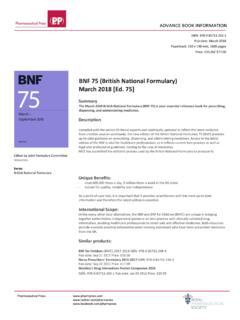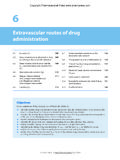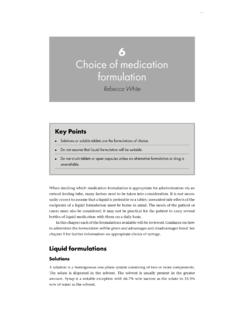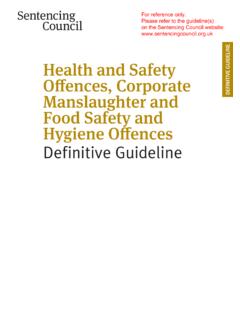Transcription of Handbook of Extemporaneous Preparation - Pharmaceutical …
1 Sample chapter copyright Pharmaceutical Press 2. Risk management Introduction The Extemporaneous Preparation of medicines is associated with a number of potential risks to patients, healthcare staff and their organisation. These all need to be carefully considered in determining the best treatment option; they then need to be minimised when the use of this category of medicine is necessary. A risk assessment should be performed before mak- ing a decision to extemporaneously prepare a medicine in line with the local unlicensed medicines policy. This process should be underpinned with a procedure in place and records of risk assessments should be maintained on file.
2 This section gives guidance on the risks associated with Extemporaneous Preparation , the assessment and management of these risks and alternative options to Extemporaneous Preparation . Legal background and organisational risks Medicines legislation requires that medicinal products are licensed before they are marketed in the UK. Accordingly no medicinal product may be placed on the market without a marketing authorisation. The marketing authorisation provides assurance of the safety and efficacy of the drug in relation to a specified use, which has been reviewed and accepted by an official expert body. It also defines the legal status of the product and assures its quality.
3 A marketing authorisation specifies the clin- ical condition(s), dose(s), routes of administration, and packaging for the particular Preparation , all of which are detailed in the Summary of Product Characteristics (SPC). Extemporaneously prepared medicines are unlicensed medicines and are not subject to these regulatory safeguards. Therefore neither prescribers nor pharmacists can make the same assumptions of quality, safety and efficacy about these products as they do for licensed medicines. It should also be noted that the Extemporaneous Preparation of medi- cines from licensed starting materials ( tablets, capsules, injections). Sample chapter from Handbook of Extemporaneous Preparation 12 | Handbook of Extemporaneous Preparation also removes these regulatory safeguards unless specifically covered in the SPC.
4 It is therefore an area of Pharmaceutical activity which carries poten- tially increased risk to the patient, the supervising pharmacist and any other healthcare professionals involved in Preparation and/or adminis- tration. The pharmacist responsible for preparing or procuring an extemporane- ously prepared medicine should therefore take responsibility for ensuring that the medicine is of suitable quality, and is safe and efficacious. A failure to do so puts both the pharmacist and organisation at risk in terms of both civil liability (negligence, breach of contract: Sale and Supply of Goods Act 1974). and criminal liability (Medicines Act 1968, Health and Safety at Work Act 1974, corporate manslaughter and corporate homicide Act 2007 , Consumer Protection Act 1987).
5 The pharmacist should also ensure that the prescriber is aware of the unlicensed status of the medicine and any associated risks with its use. Extemporaneous Preparation should therefore only be considered when an equivalent licensed product is unavailable or is unsuitable for use and if the use can be clearly justified clinically and pharmaceutically. Consideration should be given to all alternatives before choosing this option. However, it is recognised that some patients may have special clinical needs that cannot be met by licensed medicinal products or by a viable alternative option. In these circumstances it would be inappropriate to curtail the patient's treatment, as this would have a detrimental effect on their condition.
6 Whenever carrying out a risk assessment, the risks of not treating the patient should also be considered and be at the forefront of the decision- making process. Alternatives to Extemporaneous Preparation There are a number of alternative options that should be carefully consid- ered as part of a patient-specific clinical risk assessment before opting for Extemporaneous Preparation . Each option has its own associated merits and risks, and the best option will vary according to specific circumstances surrounding both the patient's condition and the urgency of commencing the treatment. Therapeutic substitution The use of a licensed medicine from the same therapeutic classification should be considered and may provide a better clinical option than the use of an extemporaneously prepared medicine which has limited data to support its formulation and stability.
7 However, the decision to switch to a different Sample chapter from Handbook of Extemporaneous Preparation Risk management | 13. medicine should also take into account the condition of the patient and the relative toxicity of the drug. For example, if a patient is stabilised on a medicine with a narrow therapeutic index, it may have a more detrimental impact on the patient's well-being to switch to a different, but therapeutically equivalent drug, than use a medicine that has been extemporaneously pre- pared against a validated formulation. However, in either case, the patient should be closely monitored following the change to their treatment to ensure their condition remains under control.
8 The use of a less potent steroid rather than diluting a potent agent is an example where a therapeutic alternative may eliminate the need for an extem- poraneous Preparation . The use of an alternative route of administration, for example use of the rectal rather than the oral route, could also be considered if an appropriate formulation is available. Procurement options Use of an imported product The importation of a suitable product that carries a marketing authorisation in its country of origin should be considered. However, it must be noted that the presence of a non-UK marketing authorisation confers no legal status on the medicine in the UK and that importation can only take place through a company holding a Wholesale Dealer (Import) Licence.
9 The Preparation selected should be licensed for use in a country with equivalent or similar licensing arrangements and regulatory standards to the UK ( EU, Canada, Australasia). This will provide the requesting pharma- cist with assurance that the quality, safety and efficacy of the medicine have been reviewed by a competent regulatory authority. However, care should be taken to ensure that the medicine has been licensed for use in the country of origin and placed on the market there, rather than being manufactured solely for export. The procuring pharmacist should also ensure that the company used for importation has adequate quality systems in place to ensure that the medicine comes from a reputable source; that counterfeit detection measures are in place; and that the cold chain (where appropriate) is maintained to the point of delivery (see Chapter 11 for more details).
10 From a clinical perspective, the procuring pharmacist needs to be aware that if the medicine is being used outside of its intended purpose, the safety and efficacy review may not apply to their specific clinical indication. Therefore it is important that the procuring pharmacist reviews the SPC and patient information leaflet (PIL) to ensure that they are appropriate for the intended use and provide alternative guidance if necessary. Sample chapter from Handbook of Extemporaneous Preparation 14 | Handbook of Extemporaneous Preparation Patient information, user guidance and the label must include comprehen- sive, relevant information in English. When importing a product from a non- English-speaking country, provision must be made to ensure that the product is labelled appropriately and that sufficient guidance is provided to the clini- cian and patient to ensure safe use.










